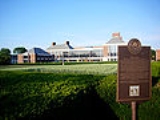
Morrow Plots
Encyclopedia
The Morrow Plots is an experimental corn
field at the University of Illinois at Urbana-Champaign
and is the oldest of its kind in the Western hemisphere
and the second oldest in the world. It was established in 1876 as the first experimental corn field at an American college and continues to be used today, although with three plots instead of the original ten. The Morrow Plot, along with the neighboring University of Illinois Observatory
, was designated as a National Historic Landmark
on May 23, 1968.
It is popularly believed that the University constructed an undergraduate library with three stories underground, so that the library would not block the sun. However, the University master plan at the time called for a large open plaza on that end of campus, which was an equally important reason the library was built underground.
Maize
Maize known in many English-speaking countries as corn or mielie/mealie, is a grain domesticated by indigenous peoples in Mesoamerica in prehistoric times. The leafy stalk produces ears which contain seeds called kernels. Though technically a grain, maize kernels are used in cooking as a vegetable...
field at the University of Illinois at Urbana-Champaign
University of Illinois at Urbana-Champaign
The University of Illinois at Urbana–Champaign is a large public research-intensive university in the state of Illinois, United States. It is the flagship campus of the University of Illinois system...
and is the oldest of its kind in the Western hemisphere
Western Hemisphere
The Western Hemisphere or western hemisphere is mainly used as a geographical term for the half of the Earth that lies west of the Prime Meridian and east of the Antimeridian , the other half being called the Eastern Hemisphere.In this sense, the western hemisphere consists of the western portions...
and the second oldest in the world. It was established in 1876 as the first experimental corn field at an American college and continues to be used today, although with three plots instead of the original ten. The Morrow Plot, along with the neighboring University of Illinois Observatory
University of Illinois Observatory
The University of Illinois Astronomical Observatory was constructed in 1896. It stands on South Matthews Avenue in Urbana, Champaign County, Illinois. The observatory was listed on the National Register of Historic Places on November 6, 1986 and on December 20, 1989, the U.S. Department of Interior...
, was designated as a National Historic Landmark
National Historic Landmark
A National Historic Landmark is a building, site, structure, object, or district, that is officially recognized by the United States government for its historical significance...
on May 23, 1968.
It is popularly believed that the University constructed an undergraduate library with three stories underground, so that the library would not block the sun. However, the University master plan at the time called for a large open plaza on that end of campus, which was an equally important reason the library was built underground.

